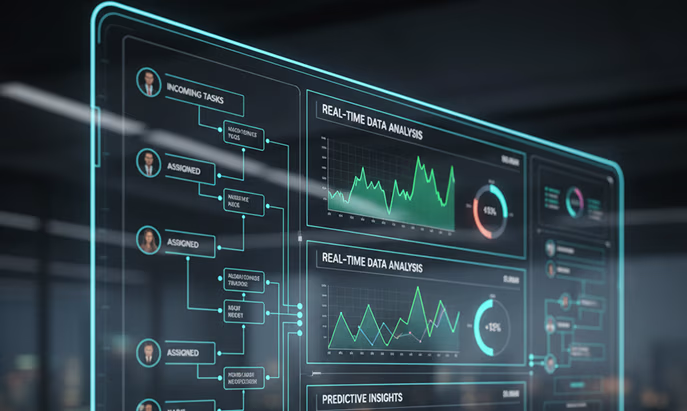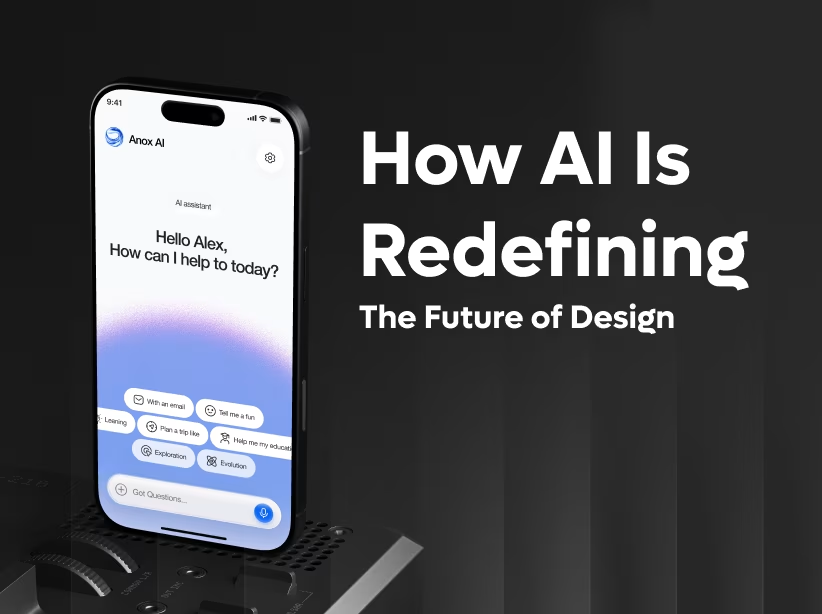Table of Contents
- The Evolution of Workflows in the Age of AI
- Why AI Workflow Automation Matters
- The Foundation: Data and Integration Readiness
- Overcoming Barriers to AI Adoption
- Monitoring and Measuring Workflow Performance
- Enhancing Operational Efficiency Through Predictive Insights
- Enhancing Operational Efficiency Through Predictive Insights
- Conclusion

In today’s competitive digital economy, efficiency is the currency of success. Businesses that adapt, automate, and analyze faster than others naturally dominate their industries. The driving force behind this evolution is artificial intelligence, better known as AI. Far beyond chatbots and recommendation systems, AI now fuels a new era of intelligent workflow automation—one where repetitive processes become self-improving systems, and human decision-making becomes data-backed and faster. For business owners, operations managers, technology leaders, product managers, and digital transformation teams, understanding how to integrate AI into workflows is no longer optional—it’s the foundation of modern operational excellence.
Integrating AI into workflows doesn’t just mean layering new software over old systems. It means redefining how teams collaborate, how information flows, and how performance is measured. Whether you’re automating customer support, streamlining inventory management, or improving project scheduling, AI allows you to create smarter, more adaptive workflows that continuously learn and optimize themselves. In this guide, we’ll explore nineteen essential aspects of AI integration—from identifying automation opportunities to real-world examples of AI-powered business processes—so you can build workflows that truly evolve with your organization.
The Evolution of Workflows in the Age of AI

Traditional workflows were designed around manual coordination, human approvals, and static rules. They served their purpose when businesses operated at slower speeds, but in a digital-first environment, this rigidity limits growth. AI introduces adaptability into workflows. Instead of hard-coded processes, AI-driven workflows can react to new data, identify inefficiencies, and even make predictive decisions before humans intervene. This shift allows operations managers to focus on outcomes rather than tasks, moving from reactive management to proactive leadership.
AI workflow automation transforms every layer of a business—from the back office to customer-facing operations. Intelligent automation tools can process information in real time, detect anomalies, and adjust workflows automatically. The result is a continuous cycle of learning and optimization that helps businesses evolve faster and more intelligently than their competition.
Why AI Workflow Automation Matters

Integrating AI into daily operations is not about replacing human effort—it’s about amplifying it. With AI workflow automation, organizations can eliminate repetitive, low-value activities while enhancing the accuracy and speed of decision-making. AI-powered systems analyze data far beyond human capability, connecting patterns across departments and generating insights that were previously invisible.
For instance, an AI-driven scheduling system can automatically assign tasks based on employee capacity, skills, and predicted workload, reducing project bottlenecks. Similarly, predictive analytics for inventory management allows retailers to restock products based on consumer behavior patterns and seasonal demand, preventing shortages or overstocking. In both cases, AI not only optimizes process efficiency but also frees human talent to focus on creativity and strategy.
Understanding AI’s Role in Business Process Optimization
AI plays a central role in business process optimization by transforming static workflows into adaptive, self-improving systems. It integrates data from various sources—CRM platforms, ERP systems, analytics dashboards—and learns to recognize inefficiencies. Machine learning for operations helps businesses predict outcomes and identify performance gaps before they impact productivity.
AI in business operations allows organizations to continuously improve through real-time feedback loops. A finance department can use AI to detect anomalies in expense claims, while a product management team can analyze user behavior to refine feature rollouts. These improvements don’t occur once—they compound over time, leading to exponential operational efficiency improvements.
The Foundation: Data and Integration Readiness
Before AI can make workflows smarter, a business must ensure its data infrastructure is ready. AI-driven workflows rely heavily on high-quality, clean, and integrated data. Without unified data streams, even the most advanced AI systems produce inconsistent results. Technology leaders need to establish centralized data repositories, ensuring that information from marketing, finance, operations, and customer experience can flow seamlessly.
Integrating AI into workflows also means connecting it with analytics visualization tools, KPI dashboards, and performance metrics dashboards. When your systems speak the same language, AI can process insights holistically rather than in isolation, leading to more reliable decision-making and better workflow optimization.
Aligning AI With Organizational Goals
AI adoption should always begin with clarity of purpose. Businesses often fail at AI integration because they start with technology rather than strategy. Each AI-driven workflow must directly tie to a measurable goal—whether that’s reducing operational costs, accelerating response times, improving customer satisfaction, or increasing overall productivity.
By aligning AI workflows with company KPIs, you create a clear framework for success. For instance, an operations manager can use AI productivity tools to track cycle time reduction, while digital transformation teams can measure adoption rates and cost savings through real-time data insights. This alignment ensures that every AI initiative supports broader organizational objectives rather than functioning as isolated tech experiments.
Designing AI-Driven Workflows
Designing AI-driven workflows requires merging the logic of data science with the empathy of user experience. A well-designed workflow should be transparent, easy to monitor, and adaptable. Product managers and UX designers must ensure that AI outputs remain explainable and that users can override decisions when needed.
Dashboard usability plays a critical role here. An intuitive business intelligence UI gives users control and visibility into automated processes, while interactive dashboards enable real-time collaboration between humans and machines. The key principle is to design automation that enhances, not overwhelms, the human experience.
The Role of Intelligent Process Automation
Intelligent process automation, or IPA, represents the next step beyond traditional automation. It blends robotic process automation (RPA) with AI and machine learning to create systems that don’t just execute rules—they understand context. In practice, this means that AI can learn from historical data, interpret unstructured inputs like text or images, and make nuanced decisions that improve over time.
For example, a financial services company might use IPA to analyze thousands of loan applications, detecting subtle risk factors that humans might overlook. In customer service, intelligent automation can understand tone and sentiment in messages, enabling faster and more empathetic responses. These examples illustrate how AI is turning automation from a mechanical function into an intelligent partner for business growth.
Overcoming Barriers to AI Adoption
Despite its benefits, many businesses struggle with AI adoption due to fears around complexity, cost, and cultural change. Successful integration requires education, trust, and incremental implementation. Technology leaders must communicate that AI is not about replacing jobs but enhancing human capability.
A practical strategy is to start small automate a single, well-defined workflow that yields measurable value. Once the benefits are visible, teams become more open to expanding AI adoption. This step-by-step approach builds organizational confidence while minimizing resistance and risk.
Real-World Examples of AI-Driven Workflows
Businesses across industries are already integrating AI into workflows with remarkable results. For example, e-commerce companies use AI-assisted decision-making for personalized recommendations and dynamic pricing, increasing conversion rates while reducing manual analysis. Logistics companies apply predictive analytics for route optimization, cutting fuel costs and delivery times.
In another case, an HR platform integrated machine learning for operations to match candidates with roles based on personality traits and performance metrics. The result was a 40% improvement in hiring efficiency. These examples demonstrate how AI workflow automation drives tangible improvements across departments—from marketing to manufacturing to human resources.
The Human-AI Collaboration Model
The most successful AI-driven workflows are not fully autonomous—they are collaborative. Human-in-the-loop systems ensure oversight, ethical consideration, and contextual awareness. While AI handles routine or data-heavy tasks, humans provide judgment, creativity, and empathy.
For business owners, this model enhances trust. Employees feel empowered rather than replaced, and organizations benefit from the combined strengths of human intuition and machine precision. This balance is essential for building sustainable, ethical, and effective AI ecosystems.
Monitoring and Measuring Workflow Performance
AI integration is not a one-time event—it’s an evolving process that requires constant monitoring. Businesses must track performance through analytics visualization tools and KPI dashboards that display metrics such as task completion time, error reduction, and process throughput.
By continuously measuring outcomes, organizations can fine-tune AI models, retrain them on updated data, and ensure they align with changing goals. Real-time data insights help teams identify when workflows need intervention or when new optimization opportunities emerge.
Ensuring Ethical and Responsible AI Integration
As businesses increase their reliance on AI, ethical considerations become crucial. Bias, transparency, and accountability should be central to every AI workflow design. Establishing review protocols and clear data governance policies ensures that AI-driven decisions remain fair, explainable, and compliant with regulations.
Responsible AI design not only builds trust but also protects long-term brand reputation. When users understand how and why AI systems make decisions, adoption rates rise and skepticism falls, leading to smoother digital transformation with AI.
AI and Digital Transformation Synergy
Digital transformation and AI integration are deeply intertwined. AI is the engine that drives smarter systems, while digital transformation provides the structure and culture to support it. Together, they enable businesses to move beyond automation and towards continuous learning.
For example, integrating AI into cloud-based SaaS platforms allows companies to scale automation rapidly. Fintech firms use AI to monitor transactions for anomalies, while analytics platforms integrate AI to visualize performance metrics dynamically. These synergies exemplify how digital transformation with AI fosters innovation and resilience.
Enhancing Operational Efficiency Through Predictive Insights
Predictive analytics is one of AI’s most transformative capabilities. It enables organizations to anticipate events rather than react to them. Manufacturing firms use AI to forecast equipment maintenance, while retailers use it to predict demand fluctuations. These predictive models feed directly into workflows, automatically triggering adjustments that prevent disruption.
By embedding predictive models within AI-driven workflows, companies enhance operational efficiency and reduce downtime. This proactive approach represents the difference between surviving and thriving in data-driven markets.
The Role of Visualization in AI Workflows
Data visualization UI plays a vital role in making AI outputs understandable to humans. Interactive dashboards convert complex analytics into clear visual narratives, empowering decision-makers to grasp insights at a glance.
For business intelligence teams, visual interfaces act as the bridge between AI and action. When workflows generate real-time insights, teams can respond faster to changes and verify the accuracy of AI recommendations. This visual transparency strengthens confidence and accelerates decision-making.
Scaling AI Across Departments
Once initial AI workflows prove successful, businesses can replicate and scale them across departments. What begins as a marketing automation initiative can expand into finance, logistics, or HR. The scalability of AI workflow automation lies in its modularity—each system can integrate with others, creating a network of interconnected intelligence.
To ensure sustainable scaling, organizations must establish shared data infrastructure, standardize workflow templates, and provide training for cross-functional teams. This approach enables consistent quality and efficiency across the entire enterprise.
Building a Culture Around AI Integration
Technology can transform operations, but culture determines longevity. Building a culture that embraces AI means encouraging experimentation, rewarding data-driven decision-making, and promoting transparency. Leadership should communicate the value of AI not as a replacement but as an enabler of human potential.
When employees see how AI reduces friction and empowers their work, adoption becomes natural. A culture of curiosity and collaboration ensures that AI integration evolves smoothly rather than disruptively.
Future Trends: The Next Frontier of AI in Workflows
The future of AI-driven workflows will center around adaptability and autonomy. As models become more advanced, they’ll begin to orchestrate entire systems with minimal human input. Generative AI will design workflows dynamically, creating processes optimized for specific goals in real time.
Integration with IoT and edge computing will further enhance process efficiency with AI, allowing organizations to operate at unprecedented speed and scale. Businesses that prepare now—by building robust data ecosystems and ethical frameworks—will lead this transformation confidently.
Key Takeaways for Implementing AI Workflows
Integrating AI for smarter workflows requires a holistic approach that combines strategic alignment, technical readiness, and cultural openness. Businesses that succeed view AI not as a one-off project but as a continuous evolution. By designing user-friendly workflows, maintaining transparency, and measuring performance through KPI dashboards and analytics visualization tools, organizations can ensure sustainable growth and long-term competitiveness.
Conclusion
AI is redefining what efficiency means for modern enterprises. By integrating AI into workflows, businesses move beyond automation into true intelligence—systems that learn, adapt, and evolve alongside their people. For business owners, operations managers, product leaders, and transformation teams, the opportunity lies in acting now: start small, design thoughtfully, measure rigorously, and scale deliberately.
The future of work is not just digital it’s intelligent. Those who harness AI to build smarter workflows today will be the ones shaping the industries of tomorrow.
Frequently Asked Questions
1. How can AI improve business workflows?
AI enhances business workflows by automating repetitive tasks, predicting outcomes, and optimizing decisions in real time. It allows teams to focus on strategy rather than routine operations.
2. What are the key benefits of AI workflow automation?
The main benefits include increased efficiency, reduced human error, faster processing times, and improved decision-making based on predictive analytics.
3. How do companies measure AI workflow performance?
Organizations use KPI dashboards and analytics visualization tools to track performance metrics, ensuring AI systems align with strategic goals.
4. Which industries benefit most from AI in workflows?
Industries such as finance, healthcare, retail, logistics, and SaaS companies gain the most, as their operations generate large volumes of data ideal for AI analysis.
5. How can small businesses start integrating AI?
Small businesses can begin by automating simple workflows like customer support or data entry using affordable AI productivity tools, then gradually scale to more complex automation systems.
Fresh UI/UX Ideas, Straight to Your Inbox





